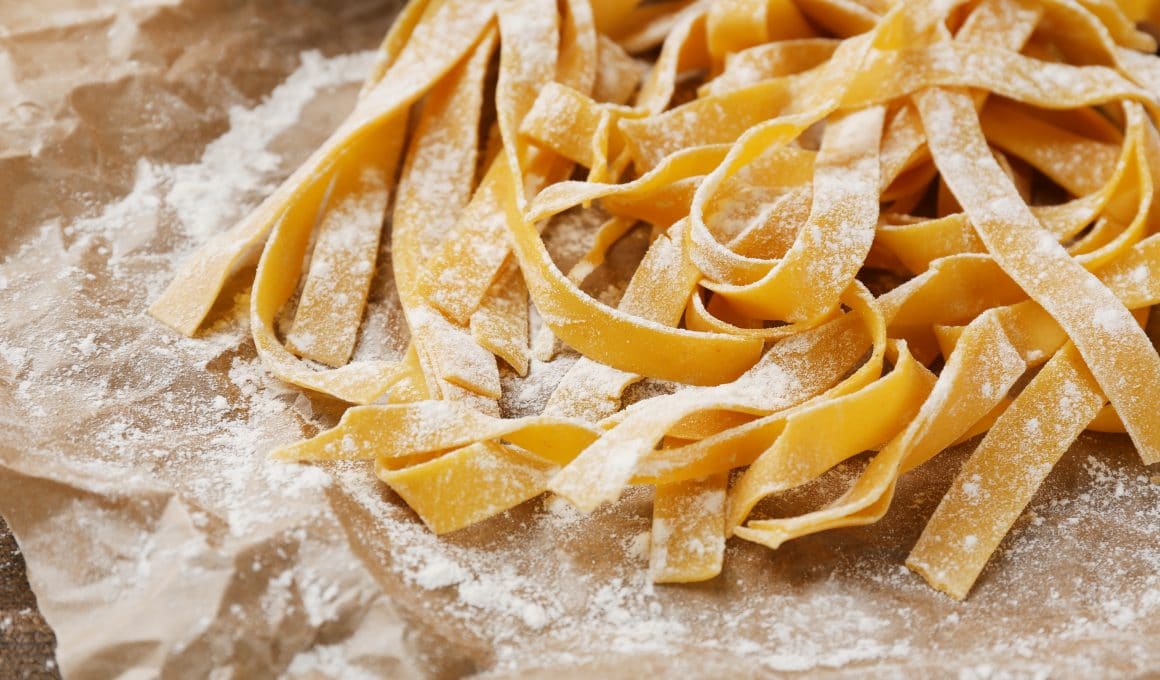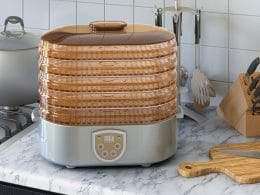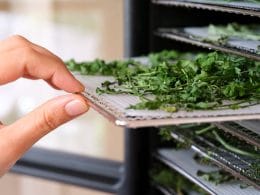Pasta is a staple food in the Mediterranean and the best way to enjoy this popular delicacy is by making it at home( according to your taste) and which also enables you to preserve it for future use. In order to store it, it must be very dried which can take several hours to accomplish. When making it at home, you have the opportunity to add all other condiments you may require such as spinach, tomatoes, garlic or peppers. Another good aspect of preparing pasta at home is that you can make a large quantity at once and afterwards, separate it into meal-sized chops, ready to pop into boiled water. So, yes, you can homemade pasta in a dehydrator.
Is it possible to dry pasta in a dehydrator?
Yes, you can dry pasta in a dehydrator. To do this, you should lay the silky strips of pasta in a single layer on one of the trays in the dehydrator in order to remove its moisture content is not more than two to four hours and at about 135 degrees Fahrenheit temperature, before you finally store it in airtight packages. Drying pasta will protect it from becoming rancid or spoilt due to the activities of microbes.
How to dry homemade pasta with a dehydrator
Drying pasta with the aid of a dehydrator is reputed to be the simplest and most effective means of preserving it when you wish to store it for a long period. Another added advantage to drying with a dehydrator is that the process can be accomplished in just mere hours. If you wish to dry your pasta in a dehydrator, lay the strips on any of the drying trays of the dehydrator and then set the temperature at about 135 degrees Fahrenheit for about four hours or even less. This will rid the pasta of any traces of moisture which will effectively check bacterial activities and consequently, preserve it for subsequent use.
How to dry homemade pasta without a food dehydrator
To preserve your pasta for future use, first spread it out onto a wide piece of baking paper so that it can form a single layer. If it is a fresh egg pasta, give it at least 30 minutes for complete dryness. Afterwards, put the pasta in a fridge for up to 24 hours before consumption. Though you are advised to consume filled pasta as soon as possible, you can still preserve it by drying for up to thirty days. If on the other hand, you are drying pasta Bianca ( a dough made of water and flour), leave it uncovered in a dry place for between 12 to 34 hours, while carefully turning it over at frequent intervals for effective drying. Alternatively, in order to hasten the drying process, you may place a fan beside your pasta to ensure even dryness. Ensure to set the fan at a relatively low setting.
The best dehydrators for drying pasta at home
It is necessary that we begin the process of recommending the best dehydrators for drying pasta by enumerating the various qualities one should look out for.
The first and most important attribute of a dehydrator that you can’t ignore is its capacity. Do you plan on making just a small quantity for a few people or large pasta for more people? Luckily, there are dehydrators of various capacities on the market that are suitable for whatever need you may have.
Secondly, check the location of the heating element in the dehydrator and make sure that no liquid will likely drip onto the food. All good dehydrators should at least be rated from about 500 to 1000 watts.
Next, a good dehydrator ought to have a built-in timer that will guard against the possibility of over-drying or even cooking food when you only plan to dehydrated it. Mos of these dehydrators come equipped with easily adjustable thermostats for drying different varieties of food items. When a dehydrator has its fan at the top of any of its sides, it prevents water from dripping onto its element and it can blend different flavours evenly and efficiently.
There is also the issue of the size of the dehydrator which is important especially where you have limited storage space either in a storage cabinet or countertop.
Finally, consider its warranty provision and study the reviews any dehydrator enjoys online before purchase.
There are other qualities to consider, but those mentioned here are some of the most relevant, which you are advised to look out for before you make any purchases. Having studied the qualities of the best dehydrators, we shall now take a critical look at some models that make the grade:
1. NESCO FD-1040 GARDENMASTER: This dehydrator offers almost all the features highlighted and hence, enjoy excellent customer reviews. This dehydrator is rated 1000 watts, it has excellent airflow with a top-mounted heater and fan.
2. PRESTO 3601 DEHYDRATOR: This dehydrator, judging by the qualities enumerated in this article, is as good as any other you can buy. It has between six to twelve drying trays( since they are expandable) and a bottom-mounted heating unit and fans too.
3. PRESTO 06301 Dehydro Digital Electric Food Dehydrator: It is rated 700 watts and has an effective drying fan with a programmable timer and a fully adjustable thermostat for optimal exposure to appropriate temperatures. It is also easy to use and clean. It is recommended for drying small size batches of food items.
4. NESCO SNACKMASTER PRO: The Nesco has got its outstanding qualities and also enjoys the status of the best selling dehydrator on Amazon. It can process different fruits, veggies, herbs, nuts, berries and many more, in just a few hours.
5. L’EQUIP 528: It is as efficient as anyother dehydrator and also boasts of all the desirable qualities you may wish for in a dehydrator. This dehydrator is most assuredly a good buy for all food drying needs.
Others which make the grade too are: COSORI Premium Stainless Steel Food Dehydrator, Tribest Sedona Express Digital Food Dehydrator, Excalibur Food Dehydrator, NutriChef Food Dehydrator Machine and Hamilton Beach Digital Food Dehydrator.
How do you freeze homemade pasta?
Freezing is another method of preserving pasta for subsequent use, but unlike drying, it does not involve any water removal. Simply put the pasta covered with a little flour into an airtight bag or alternatively, store it in a refrigerator for two days or a freezer for many weeks. The choice of which option to use is yours to make. You can also allow fresh pasta to dry up on a rack before freezing it. However, before doing this, dust the pasta strips with flour and form them into nests. This will make it easier to separate the strands whenever you thaw the pasta. In cases where you plan to freeze the pasta for several months, you are advised to place the cut pasta pieces on a baking sheet and freeze them together for about 15 minutes, and once they are frozen, transfer them into airtight bags.
What is a good dough consistency for pasta?
In order to get excellent dough consistency for making pasta, don’t overwork it. Also, it is preferable to use a dough hook in working the dough rather than a beater. When pasta is drier and looks like pie dough, it will not form a ball easily. This will make it to dry excessively and will not allow you to cut it neatly too. Your dough must be soft so that it can roll into pasta easily. Should you want to dry your pasta or freeze it completely, dry it up for 12 to 24 hours when the humidity in the air is down significantly and subsequently, store it in airtight bags when it is dry enough to snap or break. On humid days, freeze your pasta instead, just as has been explained in the article previously.
How long does dry pasta last?
This depends on the depth or severity of drying fresh pasta. To get maximum result in pasta storage, use as little eggs in it as possible or omit the eggs entirely. Humidity levels and temperature play vital roles in how long dried pasta lasts. Alternatively, you can freeze fresh pasta if you wish to prolong its shelf life. If properly conditioned, dried pasta can last for as long as six months while in storage.
How do I know how long to dry pasta?
How long the entire process takes depends on why you are drying it. For instance, if you are drying pasta for easy shaping or cooking, you may not need to dry it for longer than fifteen minutes or so. Should you dry it for longer than this period, you risk the pasta becoming too rigid and consequently breaking up or cracking into bits. If you want to store it for longer periods, leave the pasta to dry for nothing less than 24 hours at least. The pasta can dry in some 12 to 24 hours, depending on the humidity conditions and environmental heat too.
Conclusion
In all cases where we have to preserve any substance, humidity and heat play a vital role. In this regard, pasta is not an exception and so, in order to store it, its moisture content must be carefully regulated, if we must remove the chances of decay due to bacteria activity.











